- Español – América Latina
- Português – Brasil
- Tiếng Việt

Media Source Extensions

Media Source Extensions (MSE) is a JavaScript API that lets you build streams for playback from segments of audio or video. Although not covered in this article, understanding MSE is needed if you want to embed videos in your site that do things like:
- Adaptive streaming, which is another way of saying adapting to device capabilities and network conditions
- Adaptive splicing, such as ad insertion
- Time shifting
- Control of performance and download size

You can almost think of MSE as a chain. As illustrated in the figure, between the downloaded file and the media elements are several layers.
- An <audio> or <video> element to play the media.
- A MediaSource instance with a SourceBuffer to feed the media element.
- A fetch() or XHR call to retrieve media data in a Response object.
- A call to Response.arrayBuffer() to feed MediaSource.SourceBuffer .
In practice, the chain looks like this:
If you can sort things out from the explanations so far, feel free to stop reading now. If you want a more detailed explanation, then please keep reading. I'm going to walk through this chain by building a basic MSE example. Each of the build steps will add code to the previous step.
A note about clarity
Will this article tell you everything you need to know about playing media on a web page? No, it's only intended to help you understand more complicated code you might find elsewhere. For the sake of clarity, this document simplifies and excludes many things. We think we can get away with this because we also recommend using a library such as Google's Shaka Player . I will note throughout where I'm deliberately simplifying.
A few things not covered
Here, in no particular order, are a few things I won't cover.
- Playback controls. We get those for free by virtue of using the HTML5 <audio> and <video> elements.
- Error handling.
For use in production environments
Here are some things I'd recommend in a production usage of MSE related APIs:
- Before making calls on these APIs, handle any error events or API exceptions, and check HTMLMediaElement.readyState and MediaSource.readyState . These values can change before associated events are delivered.
- Make sure previous appendBuffer() and remove() calls are not still in progress by checking the SourceBuffer.updating boolean value before updating the SourceBuffer 's mode , timestampOffset , appendWindowStart , appendWindowEnd , or calling appendBuffer() or remove() on the SourceBuffer .
- For all SourceBuffer instances added to your MediaSource , ensure none of their updating values are true before calling MediaSource.endOfStream() or updating the MediaSource.duration .
- If MediaSource.readyState value is ended , calls like appendBuffer() and remove() , or setting SourceBuffer.mode or SourceBuffer.timestampOffset will cause this value to transition to open . This means you should be prepared to handle multiple sourceopen events.
- When handling HTMLMediaElement error events, the contents of MediaError.message can be useful to determine the root cause of the failure, especially for errors that are hard to reproduce in test environments.
Attach a MediaSource instance to a media element
As with many things in web development these days, you start with feature detection. Next, get a media element, either an <audio> or <video> element. Finally create an instance of MediaSource . It gets turned into a URL and passed to the media element's source attribute.

That a MediaSource object can be passed to a src attribute might seem a bit odd. They're usually strings, but they can also be blobs . If you inspect a page with embedded media and examine its media element, you'll see what I mean.
Is the MediaSource instance ready?
URL.createObjectURL() is itself synchronous; however, it processes the attachment asynchronously. This causes a slight delay before you can do anything with the MediaSource instance. Fortunately, there are ways to test for this. The simplest way is with a MediaSource property called readyState . The readyState property describes the relation between a MediaSource instance and a media element. It can have one of the following values:
- closed - The MediaSource instance is not attached to a media element.
- open - The MediaSource instance is attached to a media element and is ready to receive data or is receiving data.
- ended - The MediaSource instance is attached to a media element and all of its data has been passed to that element.
Querying these options directly can negatively affect performance. Fortunately, MediaSource also fires events when readyState changes, specifically sourceopen , sourceclosed , sourceended . For the example I'm building, I'm going to use the sourceopen event to tell me when to fetch and buffer the video.
Notice that I've also called revokeObjectURL() . I know this seems premature, but I can do this any time after the media element's src attribute is connected to a MediaSource instance. Calling this method doesn't destroy any objects. It does allow the platform to handle garbage collection at an appropriate time, which is why I'm calling it immediately.
Create a SourceBuffer
Now it's time to create the SourceBuffer , which is the object that actually does the work of shuttling data between media sources and media elements. A SourceBuffer has to be specific to the type of media file you're loading.
In practice you can do this by calling addSourceBuffer() with the appropriate value. Notice that in the example below the mime type string contains a mime type and two codecs. This is a mime string for a video file, but it uses separate codecs for the video and audio portions of the file.
Version 1 of the MSE spec allows user agents to differ on whether to require both a mime type and a codec. Some user agents don't require, but do allow just the mime type. Some user agents, Chrome for example, require a codec for mime types that don't self-describe their codecs. Rather than trying to sort all this out, it's better to just include both.
Get the media file
If you do an internet search for MSE examples, you'll find plenty that retrieve media files using XHR. To be more cutting edge, I'm going to use the Fetch API and the Promise it returns. If you're trying to do this in Safari, it won't work without a fetch() polyfill.
A production quality player would have the same file in multiple versions to support different browsers. It could use separate files for audio and video to allow audio to be selected based on language settings.
Real world code would also have multiple copies of media files at different resolutions so that it could adapt to different device capabilities and network conditions. Such an application is able to load and play videos in chunks either using range requests or segments. This allows for adaption to network conditions while media are playing . You may have heard the terms DASH or HLS, which are two methods of accomplishing this. A full discussion of this topic is beyond the scope of this introduction.
Process the response object
The code looks almost done, but the media doesn't play. We need to get media data from the Response object to the SourceBuffer .
The typical way to pass data from the response object to the MediaSource instance is to get an ArrayBuffer from the response object and pass it to the SourceBuffer . Start by calling response.arrayBuffer() , which returns a promise to the buffer. In my code, I've passed this promise to a second then() clause where I append it to the SourceBuffer .
Call endOfStream()
After all ArrayBuffers are appended, and no further media data is expected, call MediaSource.endOfStream() . This will change MediaSource.readyState to ended and fire the sourceended event.
The final version
Here's the complete code example. I hope you have learned something about Media Source Extensions.
Except as otherwise noted, the content of this page is licensed under the Creative Commons Attribution 4.0 License , and code samples are licensed under the Apache 2.0 License . For details, see the Google Developers Site Policies . Java is a registered trademark of Oracle and/or its affiliates.
Last updated 2017-02-08 UTC.
Media Source Extensions
API allowing media data to be accessed from HTML video and audio elements.
- 4 - 16 : Not supported
- 17 - 22 : Disabled by default
- 23 - 30 : Supported
- 31 - 123 : Supported
- 124 : Supported
- 125 - 127 : Supported
- 12 - 123 : Supported
- 3.1 - 7.1 : Not supported
- 8 - 17.3 : Supported
- 17.4 : Supported
- 17.5 - TP : Supported
- 2 - 24 : Not supported
- 25 - 41 : Disabled by default
- 42 - 124 : Supported
- 125 : Supported
- 126 - 128 : Supported
- 9 - 12.1 : Not supported
- 15 - 108 : Supported
- 109 : Supported
- 5.5 - 10 : Not supported
- 11 : Partial support
Chrome for Android
Safari on ios.
- 3.2 - 12.5 : Not supported
- 13 - 17.3 : Partial support
- 17.4 : Partial support
- 17.5 : Partial support
Samsung Internet
- 4 - 8.2 : Not supported
- 9.2 - 23 : Supported
- 24 : Supported
- all : Not supported
Opera Mobile
- 10 - 12.1 : Not supported
- 80 : Supported
UC Browser for Android
- 15.5 : Supported
Android Browser
- 2.1 - 4.4 : Not supported
- 4.4.3 : Supported
Firefox for Android
- 14.9 : Supported
Baidu Browser
- 13.52 : Supported
KaiOS Browser
- 2.5 : Supported
- 3 : Supported
WebKit Features in Safari 17.1
Oct 25, 2023
by Jen Simmons
Today we are pleased to share what new in WebKit for Safari 17.1. It’s now available for iOS 17 , iPadOS 17 , macOS Sonoma , macOS Ventura and macOS Monterey.
Managed Media Source
Safari 17.1 now brings the new Managed Media Source API to iPhone. Originally shipped in Safari 17.0 for iPad and Mac, Managed Media Source is a power-efficient, low-level toolkit for streaming video.
Watching streaming video is an amazing thing we all do with our devices. But to get the highest-quality video without downloading any unnecessary data and without killing the battery, it takes a complicated stack of technology working under the hood every time you hit the play button. Adaptive bitrate streaming is a technique for switching between media data formats on the fly, depending on the speed of the internet connection and capabilities of the device, even as the conditions change.
For years, many websites have used Media Source Extensions (MSE) to handle adaptive bitrate streaming. It’s a low-level toolkit that gives the web page more control and more responsibility for managing buffering and resolution. But MSE isn’t particularly good at managing buffer levels, network access, and media variant selection. Plus, it uses a lot of power, which can be especially painful on mobile devices with smaller batteries.
Managed Media Source adds the capabilities of MSE, without any of the drawbacks. We were excited to propose ManagedMediaSource to the W3C’s Media Working Group for formal standardization.
Note that support for Managed Media Source is only available when an AirPlay source alternative is present, or remote playback is explicitly disabled.
Learn all about Managed Media Source API by watching Explore media formats for the web at WWDC23.

Safari Extensions updates
Safari 17.1 also adds support for storage.session.setAccessLevel and updated storage.session to be accessed only by TRUSTED_CONTEXTS by default.
WebKit for Safari 17.1 provides multiple bug fixes and feature polish.
Accessibility
- Fixed properly exposing the expanded state of <details> elements on iOS. (109684906)
- Fixed exposing column headers of cells within role="row" elements with display: contents to assistive technologies. (115190637)
- Fixed empty accessibility label for role="treeitem" elements with display: contents who have child text starting with a newline. (115226509)
Authentication
- Fixed a bug that could cause authentication through Extensible Enterprise Single Sign-On to hang if the authentication was canceled on the server side. (105809792)
- Fixed font-size-adjust toggling font sizes for system-ui font. (111709567)
- Fixed counter values to prevent them from overflowing or underflowing. (111743827)
- Fixed auto none support for contain-intrinsic-size . (112479718)
- Fixed a positive look-behind RegExp with alternatives of different minimum lengths. (112952197)
- Fixed an issue with a workaround to handle cases where websites serve Data URLs with malformed padding. This issue prevented some images in Word documents from failing to display when hosted by Box and Sharepoint. (114573089)
- Fixed fullscreen ready check to remove the hierarchy requirement. (110004138)
- Fixed an issue where HTTP Live Streaming (HLS) videos may be offset and clipped within their video element’s frame. (110467872)
- Fixed videos disappearing when switching from landscape to portrait. (112416568)
- Fixed vertical multiline WebVTT captions getting cut off. (112951878)
- Fixed an issue where AirPods spatial audio quality is degraded after loading sites that request user media in Safari. (113604970)
- Fixed an issue where media will play with sound but no video after pressing the back button in Safari. (113605284)
- Fixed an issue where media of type application/x-mpegURL; codecs="avc1.42E01E" does not play in Safari. (113608345)
- Fixed an issue where a media element backed by MediaSource may not receive the seeked event. (114594559)
Performance
- Fixed a bug that caused poor performance when resuming WebKit-based apps, including causing a black screen or a blurry snapshot of the app’s prior state to be temporarily visible to users. (114795818)
- Fixed an issue where scrollbars would sometimes show unexpectedly in fullscreen content. (113605155)
- Fixed a bug that could cause sites to layout improperly in Private Browsing mode. (113607432)
- Fixed handling iframes with display: none . (112494003)
- Fixed an issue that could trigger a crash when web content uses WebSockets. (75425816)
- Fixed intermittent removal of adoptedStyleSheet CSSStyleSheet instances when assigning an adoptedStyleSheet array. (107768559)
- Fixed: Improved the performance of IntersectionObserver operations during scrolling. (111120491)
- Fixed ElementInternals.setFormValue(<nullish value>) to clear the submission value. (111802198)
- Fixed keyboard scroll not stopping after pressing the down arrow if keyup is default prevented. (112396756) (FB12647732)
- Fixed window.postMessage with OffscreenCanvas with an isolated world message listener. (112618195)
- Fixed a bug that could cause a nested popover element within a shadow DOM to improperly dismiss its ancestor popover. (113604250)
- Fixed handling dismissed notifications on macOS. (113756668)
Web Inspector
- Fixed objects logged to the console with multiple private fields that use the same name. (109215331)
- Fixed: Stopped using Number.prototype.toLocaleString() for numeric console format specifiers. (112170843)
- Fixed an issue which would cause unnecessary “WebGL: context lost.” errors after Safari has been moved to the background on iPadOS. (115500744)
If you are running macOS Ventura or macOS Monterey, you can update Safari by going to Software Update, and clicking “More info”. On macOS Ventura, that’s > System Settings > General > Software Update > More info. To get Safari 17.1 on your iPhone or iPad, go to Settings > General > Software Update, and tap to update.
Download the latest Safari Technology Preview to stay at the forefront of the web platform and to use the latest Web Inspector features.
We love hearing from you. To share your thoughts on Safari 17.1, find us on Mastodon at @[email protected] and @[email protected] . Or send a reply on X to @webkit . If you run into any issues, we welcome your feedback on Safari UI, or your WebKit bug report about web technologies or Web Inspector. Filing issues really does make a difference.
You can also find this information in the Safari 17.1 release notes .
- Skip to main content
- Select language
- Skip to search
Media Source Extensions API
This is an experimental technology Because this technology's specification has not stabilized, check the compatibility table for usage in various browsers. Also note that the syntax and behavior of an experimental technology is subject to change in future versions of browsers as the specification changes.
The Media Source Extensions API (MSE) provides functionality enabling plugin-free web-based streaming media. Using MSE, media streams can be created via JavaScript, and played using element is used to embed sound content in documents. It may contain one or more audio sources, represented using the src attribute or the <source> element; the browser will choose the most suitable one. It can also be the destination for streamed media, using a MediaStream." href="../../HTML/Element/audio.html"> <audio> and element to embed video content in a document." href="../../HTML/Element/video.html"> <video> elements.
Concepts and usage
Playing video and audio has been available in web applications without plugins for a few years now, but the basic features offered have only really only been useful for playing single whole tracks. We can't, for example, combine/split arraybuffers. Streaming media has up until recently been the domain of Flash, with technologies like Flash Media Server serving video streams using the RTMP protocol.
The MSE standard
With Media Source Extensions (MSE), this is changing. MSE allows us to replace the usual single track src value fed to media elements with a reference to a MediaSource object, which is a container for information like the ready state of the media for being played, and references to multiple SourceBuffer objects that represent the different chunks of media that make up the entire stream. MSE gives us finer grained control over how much and how often content is fetched, and some control over memory usage details, such as when buffers are evicted. It lays the groundwork for adaptive bitrate streaming clients (such as those using DASH or HLS) to be built on its extensible API.
Creating assets that work with MSE in modern browsers is a laborious process, taking both significant time, computing power, and energy. The usage of external utilities to massage the content into a suitable format is required. While browser support for the various media containers with MSE is spotty, usage of the H.264 video codec, AAC audio codec, and MP4 container format is a common baseline. MSE also provides an API for runtime detection of container and codec support.
If you do not require explicit control of video quality over time, the rate at which content is fetched, or the rate at which memory is evicted, then the element to embed video content in a document." href="../../HTML/Element/video.html"> <video> and element specifies multiple media resources for either the <picture>, the <audio> or the <video> element. It is an empty element. It is commonly used to serve the same media content in multiple formats supported by different browsers." href="../HTML/Element/source.html"> <source> tags may well be a simple and adequate solution.
Dynamic Adaptive Streaming over HTTP (DASH) is a protocol for specifying how adaptive content should be fetched. It is effectively a layer built on top of MSE for building adaptive bitrate streaming clients. While there are other protocols available (such as HTTP Live Streaming (HLS)), DASH has the most platform support.
DASH moves lots of logic out of the network protocol and into the client side application logic, using the simpler HTTP protocol to fetch files. Indeed, one can support DASH with a simple static file server, which is also great for CDNs. This is in direct contrast with previous streaming solutions that required expensive licenses for propriety non-standard client/server protocol implementations.
The two most common use cases for DASH involve watching content “on demand” or “live.” On demand allows a developer to take their time transcoding the assets into multiple resolutions of various quality.
Live profile content can introduce latency due to its transcoding and broadcasting, so DASH is not suitable for real time communication like WebRTC is. It can however support significantly more client connections than WebRTC.
There are numerous available free and open source tools for transcoding content and preparing it for use with DASH, DASH file servers, and DASH client libraries written in JavaScript.
Media Source Extensions Interfaces
Extensions to other interfaces, specifications, browser compatibility.
[1] Available after switching the about:config preference media.mediasource.enabled to true . In addition, support was limited to a whitelist of sites, for example YouTube, Netflix, and other popular streaming sites. The whitelist was removed and Media Source Extensions was enabled by default in 42+ for all sites.
[2] Only works on Windows 8+.
- Transcoding assets for Media Source Extensions
- Using MSE to create a basic streaming service (TBD)
- Using MPEG DASH to create a streaming application (TBD)
- The element is used to embed sound content in documents. It may contain one or more audio sources, represented using the src attribute or the <source> element; the browser will choose the most suitable one. It can also be the destination for streamed media, using a MediaStream." href="../../HTML/Element/audio.html"> <audio> and element to embed video content in a document." href="../../HTML/Element/video.html"> <video> elements.
- HTMLMediaElement , HTMLVideoElement , elements, as well as methods to manipulate them. It derives from the HTMLMediaElement interface." href="HTMLAudioElement.html"> HTMLAudioElement .
Document Tags and Contributors
- Experimental
- Media Source Extensions
- MediaSource
- SourceBuffer
- SourceBufferList
- VideoPlaybackQuality
- TrackDefault
- TrackDefaultList
- VideoTrack.sourceBuffer
- TextTrack.sourceBuffer
- HTMLVideoElement.getVideoPlaybackQuality()
- URL.createObjectURL()
- sourceended
- sourceclose
- updatestart
- addsourcebuffer
- removesourcebuffer
- Skip to main content
- Select language
- Skip to search
- Sign in Github
- Media Source Extensions API
- 中文 (简体) (zh-CN)
- Add a translation
- Print this article
Media Source Extensions Concepts and usage
Extensions to other interfaces, specifications, browser compatibility.
This is an experimental technology Check the Browser compatibility table carefully before using this in production.
The Media Source Extensions API (MSE) provides functionality enabling plugin-free web-based streaming media. Using MSE, media streams can be created via JavaScript, and played using element is used to embed sound content in documents. It may contain one or more audio sources, represented using the src attribute or the element: the browser will choose the most suitable one. It can also be the destination for streamed media, using a MediaStream."> <audio> and ) embeds a media player which supports video playback into the document."> <video> elements.
Playing video and audio has been available in web applications without plugins for a few years now, but the basic features offered have really only been useful for playing single whole tracks. We can't, for example, combine/split arraybuffers. Streaming media has up until recently been the domain of Flash, with technologies like Flash Media Server serving video streams using the RTMP protocol.
The MSE standard
With Media Source Extensions (MSE), this is changing. MSE allows us to replace the usual single track src value fed to media elements with a reference to a MediaSource object, which is a container for information like the ready state of the media for being played, and references to multiple SourceBuffer objects that represent the different chunks of media that make up the entire stream. MSE gives us finer grained control over how much and how often content is fetched, and some control over memory usage details, such as when buffers are evicted. It lays the groundwork for adaptive bitrate streaming clients (such as those using DASH or HLS) to be built on its extensible API.
Creating assets that work with MSE in modern browsers is a laborious process, taking both significant time, computing power, and energy. The usage of external utilities to massage the content into a suitable format is required. While browser support for the various media containers with MSE is spotty, usage of the H.264 video codec, AAC audio codec, and MP4 container format is a common baseline. MSE also provides an API for runtime detection of container and codec support.
, the element, or the element."> <source> tags may well be a simple and adequate solution.
Dynamic Adaptive Streaming over HTTP (DASH) is a protocol for specifying how adaptive content should be fetched. It is effectively a layer built on top of MSE for building adaptive bitrate streaming clients. While there are other protocols available (such as HTTP Live Streaming (HLS)), DASH has the most platform support.
DASH moves lots of logic out of the network protocol and into the client side application logic, using the simpler HTTP protocol to fetch files. Indeed, one can support DASH with a simple static file server, which is also great for CDNs. This is in direct contrast with previous streaming solutions that required expensive licenses for propriety non-standard client/server protocol implementations.
The two most common use cases for DASH involve watching content “on demand” or “live.” On demand allows a developer to take their time transcoding the assets into multiple resolutions of various quality.
Live profile content can introduce latency due to its transcoding and broadcasting, so DASH is not suitable for real time communication like WebRTC is. It can however support significantly more client connections than WebRTC.
There are numerous available free and open source tools for transcoding content and preparing it for use with DASH, DASH file servers, and DASH client libraries written in JavaScript.
MediaSource interface
- Transcoding assets for Media Source Extensions
- Using MSE to create a basic streaming service (TBD)
- Using MPEG DASH to create a streaming application (TBD)
- The element is used to embed sound content in documents. It may contain one or more audio sources, represented using the src attribute or the element: the browser will choose the most suitable one. It can also be the destination for streamed media, using a MediaStream."> <audio> and ) embeds a media player which supports video playback into the document."> <video> elements.
- HTMLMediaElement , HTMLVideoElement , elements, as well as methods to manipulate them. It derives from the HTMLMediaElement interface."> HTMLAudioElement .
Document Tags and Contributors
- Experimental
- Media Source Extensions
- MediaSource
- SourceBuffer
- SourceBufferList
- VideoPlaybackQuality
- TrackDefault
- TrackDefaultList
- VideoTrack.sourceBuffer
- TextTrack.sourceBuffer
- HTMLVideoElement.getVideoPlaybackQuality()
- URL.createObjectURL()
Learn the best of web development
Get the latest and greatest from MDN delivered straight to your inbox.
Thanks! Please check your inbox to confirm your subscription.
If you haven’t previously confirmed a subscription to a Mozilla-related newsletter you may have to do so. Please check your inbox or your spam filter for an email from us.
Navigation Menu
Search code, repositories, users, issues, pull requests..., provide feedback.
We read every piece of feedback, and take your input very seriously.
Saved searches
Use saved searches to filter your results more quickly.
To see all available qualifiers, see our documentation .
- Notifications
Have a question about this project? Sign up for a free GitHub account to open an issue and contact its maintainers and the community.
By clicking “Sign up for GitHub”, you agree to our terms of service and privacy statement . We’ll occasionally send you account related emails.
Already on GitHub? Sign in to your account
iOS13: Safari for iPad to support Media Source Extensions. #2267
phillipseamore commented Jun 6, 2019
- 👍 1 reaction
johnBartos commented Jun 17, 2019
Sorry, something went wrong.
stale bot commented Aug 16, 2019
stale bot commented Oct 16, 2019
sunnybear commented Oct 29, 2019
- 😕 1 reaction
itsjamie commented Oct 29, 2019
Sunnybear commented oct 29, 2019 • edited, sunnybear commented oct 31, 2019.
- 👍 3 reactions
mattcwebster commented Nov 1, 2019
Sunnybear commented nov 1, 2019.
jonnyijapan commented Nov 6, 2019 • edited
Stale bot commented jan 5, 2020.
danielehrhardt commented Jan 13, 2020
OrenMe commented Jan 14, 2020
Stale bot commented mar 3, 2020.
robwalch commented Mar 3, 2020
No branches or pull requests
You are using an outdated browser. Please upgrade your browser to improve your experience.
Apple to unveil AI-enabled Safari browser alongside new operating systems

Safari getting new AI tools in iOS 18
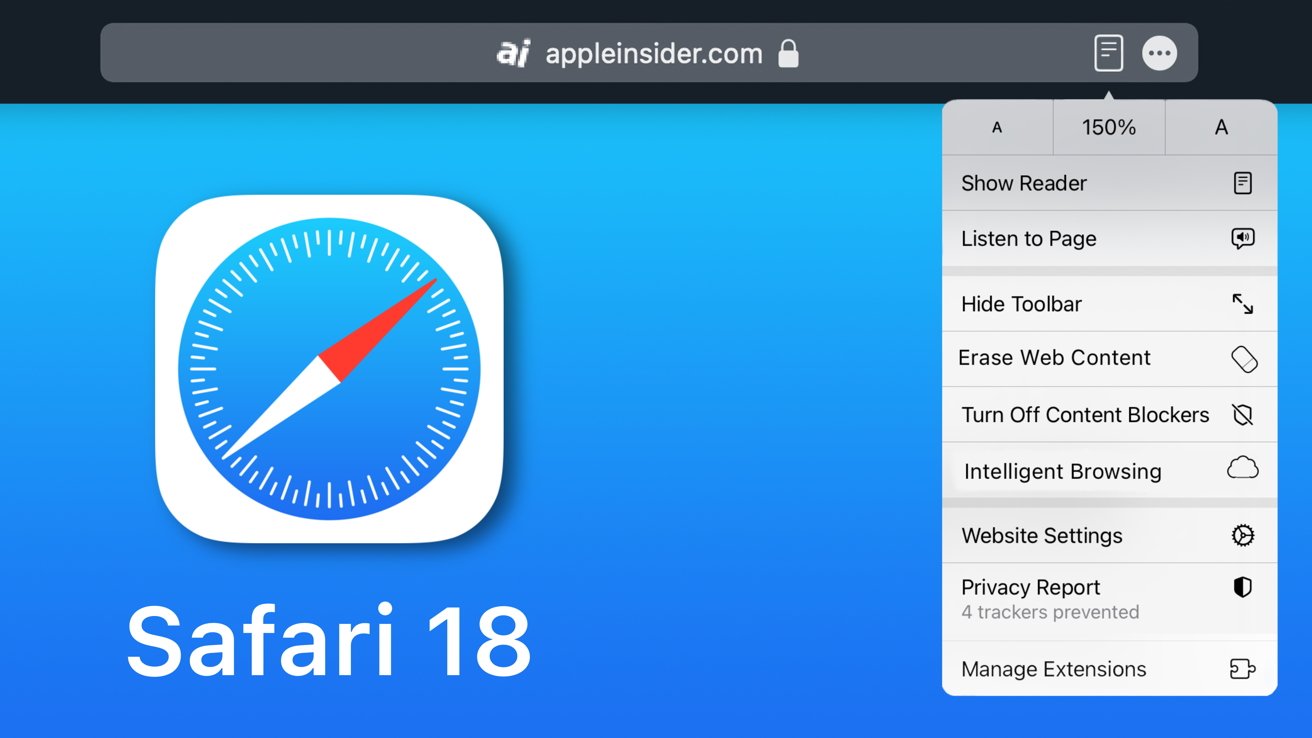
The software — expected to debut as Safari 18 later in 2024 — is currently undergoing evaluation alongside internal builds of Apple's next-generation operating system updates, namely iOS 18 and macOS 15, according to people familiar with the matter. Should all of the new features make it to the release candidate stage, users will be treated to a new user interface (UI) for customizing popular page controls, a "Web eraser" feature, and AI-driven content summarization tools.
Intelligent Search - AI-enhanced browsing and text summarization
Engineers evaluating the latest builds of Safari 18 can find a toggle for the new page controls menu within the browser's address bar. The menu consolidates — and provides quick access to — old and new page control tools, among them being the browser's new "Intelligent Search" feature.
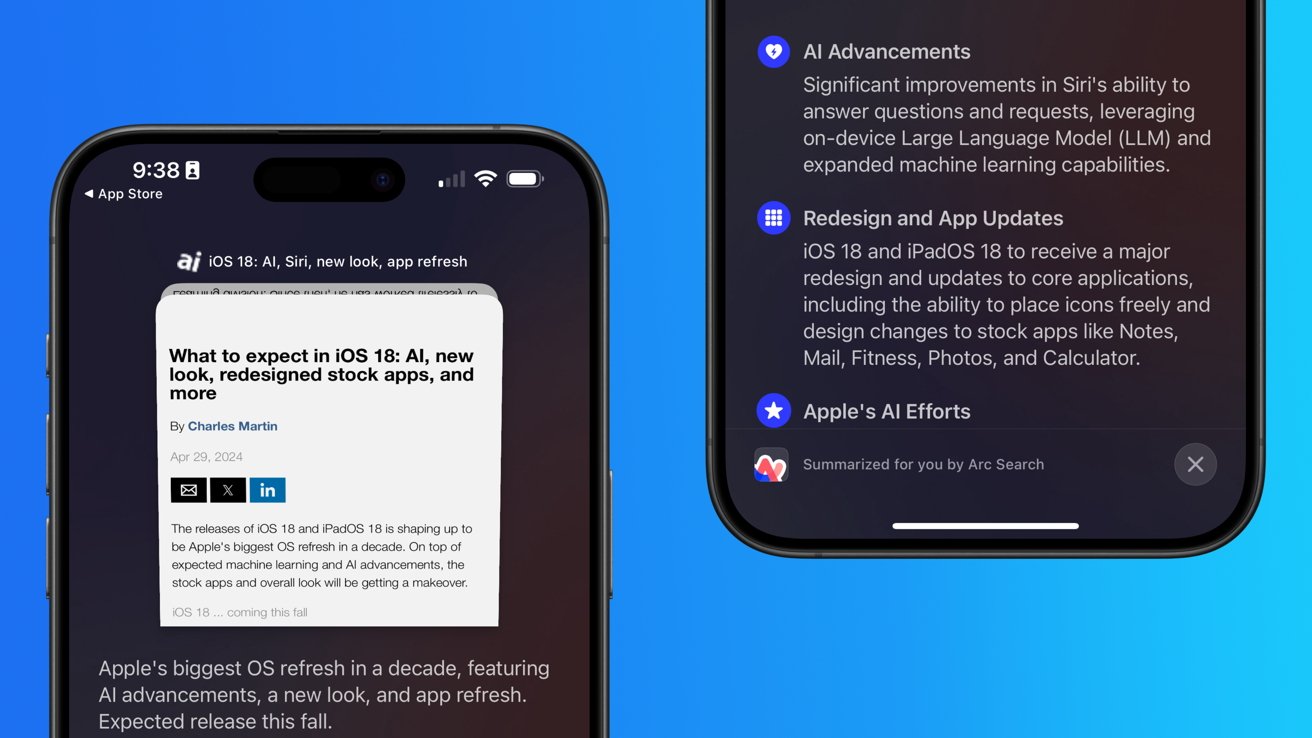
This feature is not automatically enabled in test builds of Safari 18 and instead requires manual activation from the page controls menu. Once enabled, it's believed the tool leverages Apple's on-device AI technology — specifically the Ajax language-learning model — to identify topics and key phrases within a webpage for which to base the summarization.
In selecting key phrases, Apple's LLM software identifies sentences that provide explanations or describe the structure of objects, depending on the text in question. Words repeated within a text and key sentences are recognized as text topics.
These early indications suggest Apple is striving to deliver text summarization alongside Safari 18 later this year, though the exact implementation of this feature remains fuzzy.
Apple's text summarization features could be a response to rival generative AI tools, such as OpenAI's ChatGPT. But Apple's on-device models and technologies like Private Relay could make the experience much more secure for users. Intelligent Search is also likely to be the same AI browser assistant that one X user hinted at a couple of weeks back.
Web Eraser for better content-blocking
Also accessible from the new page controls menu is a feature Apple is testing called "Web Eraser." As its name would imply, it's designed to allow users to remove, or erase, specific portions of web pages, according to people familiar with the feature.
The feature is expected to build upon existing privacy features within Safari and will allow users to erase unwanted content from any webpage of their choosing. Users will have the option to erase banner ads, images, text or even entire page sections, all with relative ease.

The erasure is said to be persistent, rather than limited to a browsing session. This means that Safari will remember the changes even after the original tab or window has been closed.
When visiting a web page with previously erased content, Safari will inform the user that the page has been modified to reflect their desired changes. The browser will also give the user the option to revert changes and restore the webpage to its initial, unaltered state.
As for where Apple got the inspiration for Web Eraser, the company could have Sherlocked the feature from the third-party app 1Blocker. The application features a similar way of erasing ads, where users would tap ads to make them disappear.
Updated UI will move key tools into one easy location
The new page controls menu referenced throughout this article will attempt to offer Safari 18 users quick and easy access to several options previously located across different menus and the Share Sheet. Running on pre-release versions of macOS 15, for instance, the menu also pulls in the "Aa" menu common on existing iPadOS versions of the browser. These include zoom options, webpage settings for privacy controls, content blocking options, extension shortcuts, and access to the new AI and erasure tools.
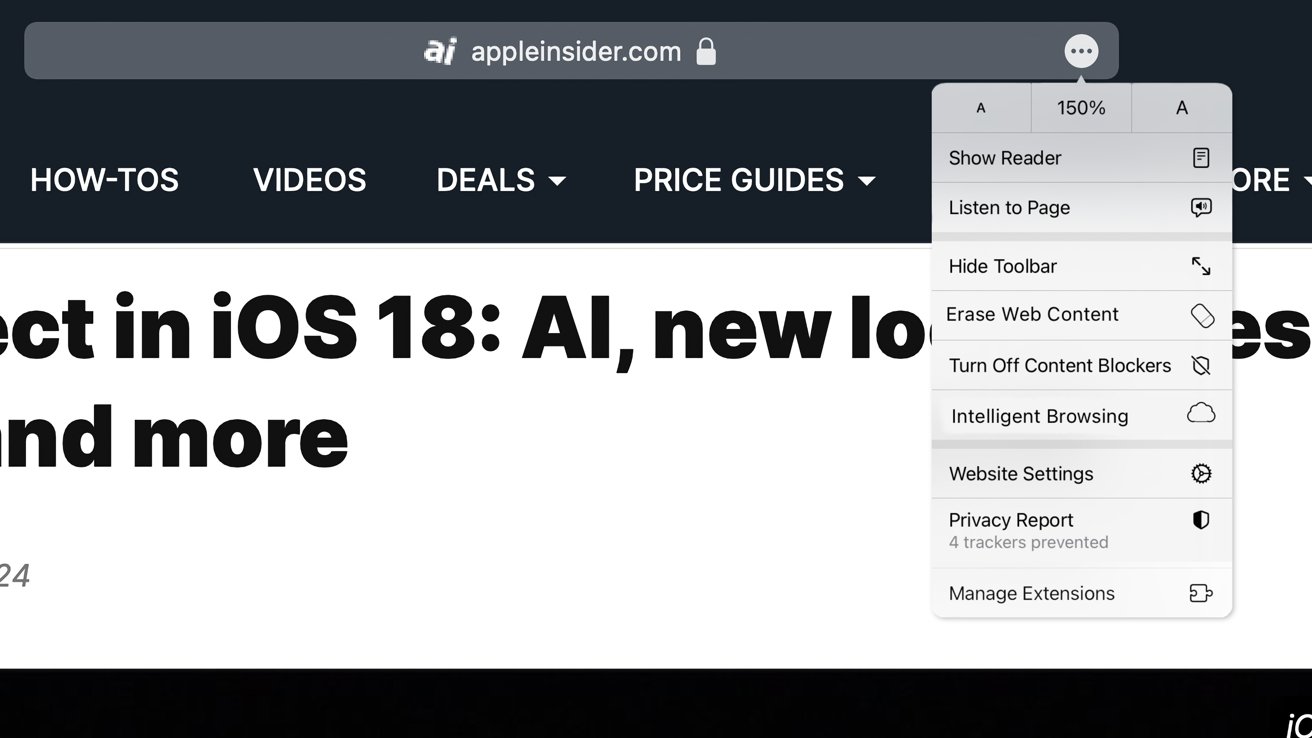
These various options existed previously on macOS, but were found by navigating through the Safari settings menu. Having all of these controls in one central location in the Address Bar will make these options more discoverable for end users. Other options like on-page text search and reader mode are also in this menu.
This all suggests Apple intends to unite the iPadOS and macOS Safari UI paradigms when it unveils its new OS releases during its Worldwide Developers Conference in June.
AI-enhanced Visual Lookup feature could be available in 2025
Simultaneously, Apple is also working on a much more powerful visual search feature scheduled for integration sometime in 2025 that will allow users to obtain information on consumer products when browsing through images. People familiar with the tool say it's similar to the Visual Lookup feature, through which Siri can identify plants, pets and landmarks from photos.
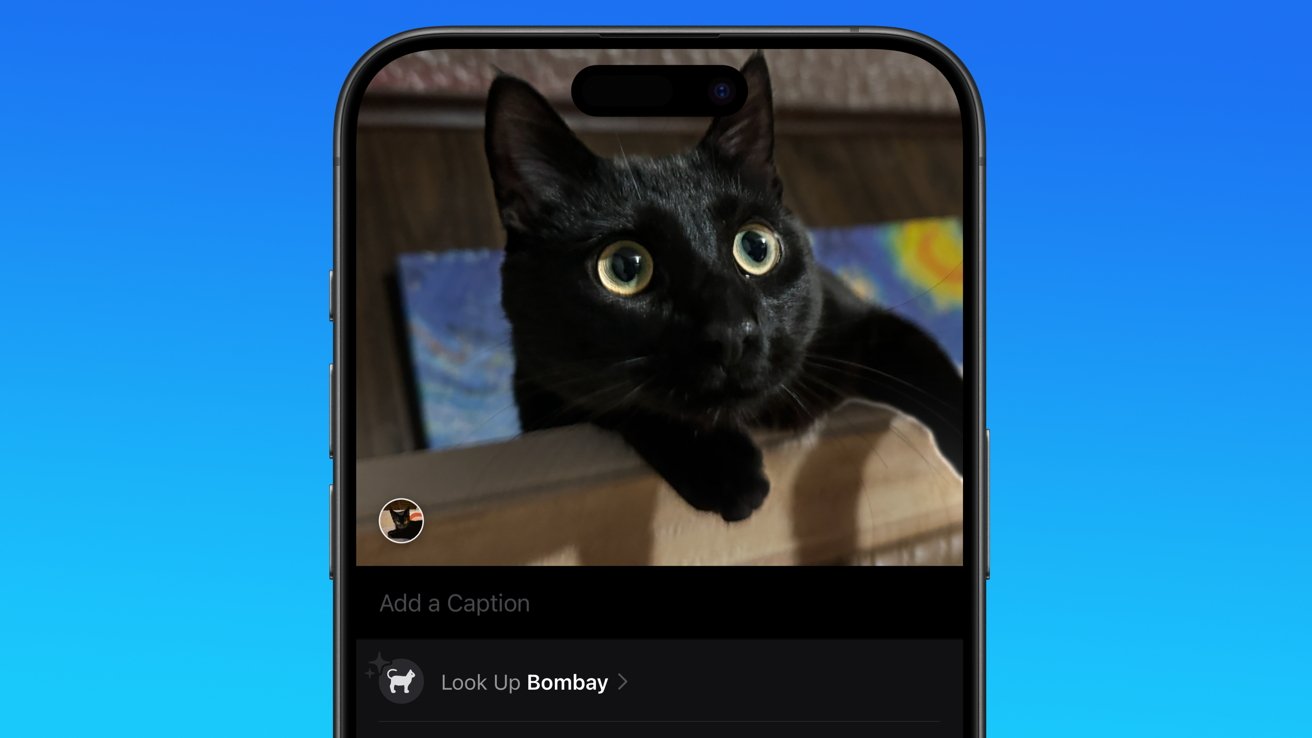
Visual Search could be implemented as a system-wide feature. So, instead of surfacing search results in the Photos app, the user may be able to use Visual Search directly in Safari by selecting an image.
Given development of this tool is in the earlier stages, it remains unclear how Apple will ultimately go about implementing it. It also remains to be seen whether or not the feature will make it through internal testing.
The iPhone maker has expressed significant interest in artificial intelligence and more recently published research related to on-device language learning models. This goes hand in hand with widespread rumors about several other AI-powered software features, many of which are expected to make their debut later this year with iOS 18.
Another big year for Safari
From its inception, Safari was always meant to rival existing web browsers.
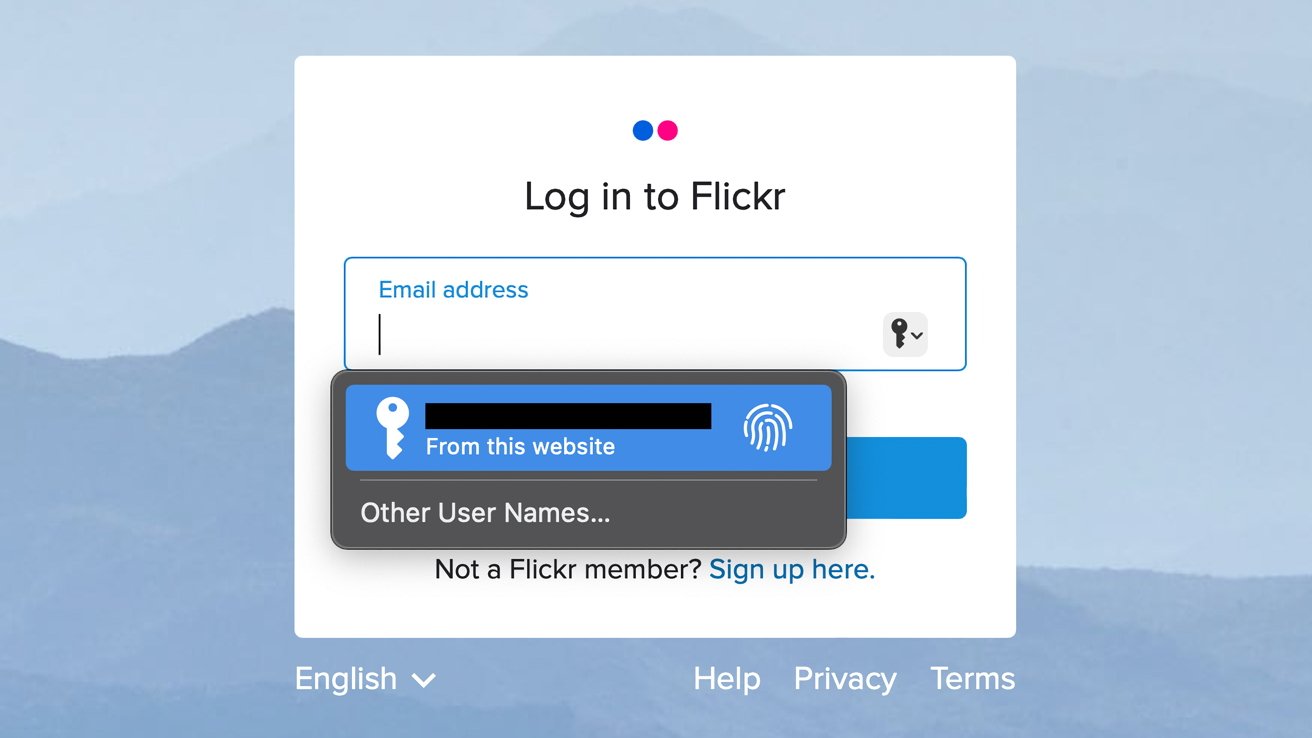
Safari was originally added to macOS as a means of replacing Microsoft's Internet Explorer for Mac, which was the default browser. Over the years, the app made its way to the iPhone , and has since received various upgrades over the years.
More recent versions of Safari provide users with personalized web suggestions, and allow for greater privacy protection with features such as iCloud Private Relay.
This latest set of enhancements only serves to better position Safari against the competition, in an ever-increasing landscape of generative AI tools and third-party ad-blockers.
While Apple tests many such features during different development stages, it is important to remember that not all of them make it to release. Apple has been known to delay features or cancel them entirely, so there's always a chance we may not see these new Safari features after all.
Along with Safari 18 and its associated improvements, we should also see a revamped Calculator with Math Notes make its way to iPadOS 18. Freeform Scenes and Adaptive Voice Shortcuts are new OS features, which are also expected to debut later this year.
Apple is expected to introduce various AI-related enhancements as part of iOS 18 and macOS 15, both of which should be announced at the company's annual WWDC on June 10.
35 Comments
"As for where Apple got the inspiration for Web Eraser, the company could have Sherlocked the feature from the third-party app 1Blocker. The application features a similar way of erasing ads, where users would tap ads to make them disappear." They may also have been inspired by Simplified Page....
As long as I can turn it off/hide it they can knock themselves out.
Will the web eraser feature remove pop up videos, such as the ones that appear on this site?
I use the 'Reader' function in Safari quite a bit, but sometimes it doesn't work very well. Seems like something that AI could help make better.
Web ads suck but how else do you think your favorite websites will stay in business? Are you prepared to pay a subscription to every site? I doubt it…
Top Stories

Save $200 on this 14-inch MacBook Pro M3 Pro with 36GB RAM, 1TB SSD

Apple charms investors with record $110B stock buyback, dividend hike

Apple blows away Wall Street earnings guesses, even with weak China iPhone sales

Apple's iOS 18 to streamline task management with unified events and reminders

Apple headphone shootout: Beats Solo 4 vs AirPods Max
Featured deals.

Amazon discounts the Apple Studio Display to $1,299 ($300 off)
Latest exclusives.


An inside look at Apple's various internal iOS variants that aid development

Apple's iOS 18 AI will be on-device preserving privacy, and not server-side

Apple's macOS 15 to get rare cognitive boost via Project GreyParrot
Latest comparisons.

M3 15-inch MacBook Air vs M3 14-inch MacBook Pro — Ultimate buyer's guide

M3 MacBook Air vs M1 MacBook Air — Compared
Latest news.

Apple Vision Pro a big hit in enterprise
During the Apple earnings call, Apple CEO Tim Cook shared that half of Fortune 100 companies have purchased Apple Vision Pro units.

Apple reversed its stock trajectory for the year in 30 minutes
Apple stock was having a tough year after some early gains — until investors erased the loss after Thursday's earnings report.

Tim Cook dismisses misguided DOJ lawsuit in the shadow of strong earnings
Ahead of Apple's second-quarter earnings call, CEO Tim Cook addressed the ongoing antitrust lawsuit filed by the US Department of Justice, calling it "misguided."

Apple CEO Tim Cook bullish on China, thinking long-term
After revealing Apple's Q2 earnings, CEO Tim Cook shared he "feels great" about China due to beating expectations in a competitive environment.

Alongside disclosing its earnings for Q2 2024, Apple also announced that it is increasing the dividend it pays to shareholders by 4%, and is also buying back more stock in one program than ever before.

Apple has released its financial results for the Q2 2024 quarter, with earnings beating predictions despite China iPhone fears.

Beats Pill revival resurfaces thanks to F1 driver Daniel Ricciardo
The unannounced Beats Pill has made another public appearance. This time, it's caught in the hand of F1 racing driver Daniel Ricciardo.

Siri on HomePod can't tell you what time it is right now
The HomePod is having an issue understanding the simple query "What time is it?" right now. Apple will probably fix it soon.

EU Core Technology Fee for small & non-profit developers pared way back
Responding to criticism that its Core Technology Fee for EU developers could see small App Store developers owing Apple excessive fees, the company has revised its rules for eligibility.

Rabbit R1 isn't an iPhone killer, because its AI can run on Apple hardware
The Rabbit R1 handheld AI device is a simple Android device, and a developer made the AI run on an iPhone.

How to use Siri in CarPlay with or without your voice
Being able to make a request using Siri while driving helps keep your eyes on the road, but just asking for Siri may not work on older cars or in certain other circumstances. Here's the fix.
Latest Videos

Beats Solo 4 headphones review: Great audio quality and features

iPhone 16 Pro: what to expect from Apple's fall 2024 flagship phone

New iPad Air & iPad Pro models are coming soon - what to expect
Latest reviews.

Unistellar Odyssey Pro review: Unlock pro-level astronomy with your iPhone from your backyard

Ugreen DXP8800 Plus network attached storage review: Good hardware, beta software

Espresso 17 Pro review: Magnetic & modular portable Mac monitor

{{ title }}
{{ summary }}
- The Inventory
Apple’s Safari Browser May Let You Erase Ads Completely With New AI Makeover
Safari could look more like arc browser on ios 18 and macos 15 with new ai summaries handled on-device..
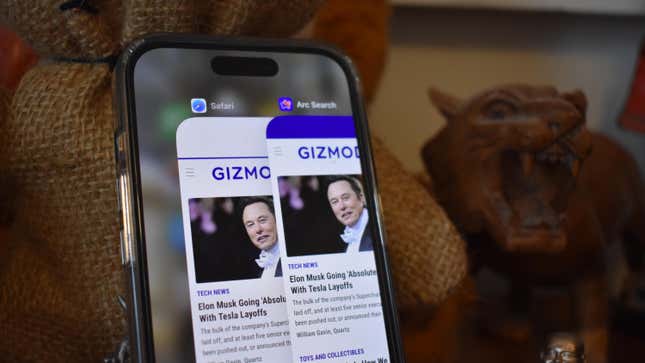
Microsoft Edge and Google Chrome are already being drowned in new AI features, so we suppose it was inevitable that Apple would also try to shove some AI activities into its default browser. With Apple reportedly jumping on the AI hype train for iOS 18 (though getting on at the caboose end rather than the passenger car) the company at the end of 1 Infinite Loop may try to shove AI summaries and browser assistants into Safari in a move that’s reminiscent of the existing Arc Browser . Unlike the competition, this time Apple could be powering it all from the device itself, rather than the cloud.
Related Content
Related products.
More interestingly, the browser could let you highlight and erase whole sections of web pages. Tired of the banner ads on top of Gizmodo’s site? If the rumors are true, Safari might have the ability to mask that. It all comes from a report from Apple Insider based on the latest builds of Safari 18 . The controls hidden in the latest test models of the browser seem to indicate Safari would paper over sections of a site you don’t want to see. Better yet, it would remember your selections and re-erase the same parts of the page if you come back to it later. You would have the option of reverting the page to its original state.
That feature is akin to apps like 1Blocker on Safari with iPhone or uBlock Origin on other browsers, two apps that allow you to apply cosmetic filters on offending ads. 1Blocker in particular tells Safari what parts of the page to open, which also may help increase the speed at which the page loads.
Of course, advertisers and online publishers would not be happy about any built-in ad-blocking features. The click-centric publishing model is already flailing with the greater push for AI in Google Search .
But this is still extremely early, and code found inside Safari 18 does not necessarily point to how Apple plans to roll out these features, if at all. But AI upgrades to Safari feel inevitable. The so-called “Intelligent Search” would use a large language model to find key phrases and words in an article as the basis for its summary. AI summaries are already available in Edge through the Copilot feature, and Chrome’s Gemini-powered assistant can perform a similar task.
AI features may be Apple’s best bet if it wants to take a hammer to Google’s search and ad monopoly. That’s what Microsoft has been doing with its Edge browser and Bing search, but so far Google Search and Chrome remain dominant in their categories. Apple is also going all-in on AI with its upcoming releases. The M4 chip , expected to debut along with the new OLED iPad Pro , will reportedly have a better neural processor than its previous M-series CPUs. Similarly, the next iPhone 16 is said to have a bunch of AI capabilities with the promise of running some of these language models or art generators on-device.
We’ll likely hear more about this when WWDC rolls around on June 10 .

Britney Spears in Huge Fight With Boyfriend, Hotel Guests Fear Mental Breakdown

Guess Which Celeb Shared This Sexy Robe Snap From Switzerland!

Orangutan Observed Treating Face Wound with Plant, First Documented Case

Nicole Scherzinger Shines In Singapore ... See The Action-Packed Pics!

Sia Legally Files to Change Her Name with Official Court Request
Barbra streisand catches hell for ozempic remark to melissa mccarthy, barbra streisand melissa mccarthy fans pissed ... after ozempic comment.
Barbra Streisand is catching a lot of heat on social media after questioning whether Melissa McCarthy used Ozempic to achieve her recent look.
It all started Sunday ... Melissa – who has long struggled with weight issues – posted a photo of her slimmer self with friend and film director, Adam Shankman , as they attended the Centre Theatre Group Gala in L.A.
Waiting for your permission to load the Instagram Media.
As you can see, Melissa looked terrific in her light green dress with a matching blazer alongside the stylish Shankman. She captioned the image with a combined message of going to the event with Shankman and getting closer to her dream of dancing onstage.
Enter Streisand ... Babs wrote in the comments section of Melissa's IG post, "Give him (Shankman) my regards did you take Ozempic?" Of course, everyone knows Ozempic is a controversial diabetes drug that can be used to lose weight.
While Barbra seemingly was not trying to be malicious, she received an avalanche of online criticism from Melissa's fans.
One supporter responded, "Wow really! What happened to not taking about Bodies!"
Another said, "I’m so totally taken aback that you could ask her that on Social Media for all to see?"
Barbra's Ozempic Comment ...
- Totally Fair
A third wrote, "Whether she did or did not is no one else’s business." And still others described Barbra's question as "rude," "nasty" and "disgusting."
All the backlash prompted Barbra to later remove her comment. Melissa has yet to say anything about the kerfuffle. We'll update you if she does.
- Share on Facebook
related articles

Mama June Turns to Weight Loss Injections After Packing on 130 Lbs

Oprah Explores Prescription Weight Loss Drug Impact in Upcoming TV Special
Old news is old news be first.
To revisit this article, visit My Profile, then View saved stories .
- Backchannel
- Newsletters
- WIRED Insider
- WIRED Consulting
Vittoria Elliott
A Lawsuit Argues Meta Is Required by Law to Let You Control Your Own Feed

A lawsuit filed Wednesday against Meta argues that US law requires the company to let people use unofficial add-ons to gain more control over their social feeds.
It’s the latest in a series of disputes in which the company has tussled with researchers and developers over tools that give users extra privacy options or that collect research data. It could clear the way for researchers to release add-ons that aid research into how the algorithms on social platforms affect their users, and it could give people more control over the algorithms that shape their lives.
The suit was filed by the Knight First Amendment Institute at Columbia University on behalf of researcher Ethan Zuckerman, an associate professor at the University of Massachusetts—Amherst. It attempts to take a federal law that has generally shielded social networks and use it as a tool forcing transparency.
Section 230 of the Communications Decency Act is best known for allowing social media companies to evade legal liability for content on their platforms. Zuckerman’s suit argues that one of its subsections gives users the right to control how they access the internet, and the tools they use to do so.
“Section 230 (c) (2) (b) is quite explicit about libraries, parents, and others having the ability to control obscene or other unwanted content on the internet,” says Zuckerman. “I actually think that anticipates having control over a social network like Facebook, having this ability to sort of say, ‘We want to be able to opt out of the algorithm.’”
Zuckerman’s suit is aimed at preventing Facebook from blocking a new browser extension for Facebook that he is working on called Unfollow Everything 2.0. It would allow users to easily “unfollow” friends, groups, and pages on the service, meaning that updates from them no longer appear in the user’s newsfeed.
Zuckerman says that this would provide users the power to tune or effectively disable Facebook’s engagement-driven feed. Users can technically do this without the tool, but only by unfollowing each friend, group, and page individually.
There’s good reason to think Meta might make changes to Facebook to block Zuckerman’s tool after it is released. He says he won’t launch it without a ruling on his suit. In 2020, the company argued that the browser Friendly, which had let users search and reorder their Facebook news feeds as well as block ads and trackers, violated its terms of service and the Computer Fraud and Abuse Act. In 2021, Meta permanently banned Louis Barclay , a British developer who had created a tool called Unfollow Everything, which Zuckerman’s add-on is named after.
“I still remember the feeling of unfollowing everything for the first time. It was near-miraculous. I had lost nothing, since I could still see my favorite friends and groups by going to them directly,” Barclay wrote for Slate at the time. “But I had gained a staggering amount of control. I was no longer tempted to scroll down an infinite feed of content. The time I spent on Facebook decreased dramatically.”

Boone Ashworth

Lauren Goode

Emily Mullin

The same year, Meta kicked off from its platform some New York University researchers who had created a tool that monitored the political ads people saw on Facebook. Zuckerman is adding a feature to Unfollow Everything 2.0 that allows people to donate data from their use of the tool to his research project. He hopes to use the data to investigate whether users of his add-on who cleanse their feeds end up, like Barclay, using Facebook less.
Sophia Cope, staff attorney at the Electronic Frontier Foundation, a digital rights group, says that the core parts of Section 230 related to platforms’ liability for content posted by users have been clarified through potentially thousands of cases. But few have specifically dealt with the part of the law Zuckerman’s suit seeks to leverage.
“There isn’t that much case law on that section of the law, so it will be interesting to see how a judge breaks it down,” says Cope. Zuckerman is a member of the EFF’s board of advisers.
John Morris, a principal at the Internet Society, a nonprofit that promotes open development of the internet, says that, to his knowledge, Zuckerman’s strategy “hasn’t been used before, in terms of using Section 230 to grant affirmative rights to users,” noting that a judge would likely take that claim seriously.
Meta has previously suggested that allowing add-ons that modify how people use its services raises security and privacy concerns. But Daphne Keller, director of the Program on Platform Regulation at Stanford's Cyber Policy Center, says that Zuckerman’s tool may be able to fairly push back on such an accusation.“The main problem with tools that give users more control over content moderation on existing platforms often has to do with privacy,” she says. “But if all this does is unfollow specified accounts, I would not expect that problem to arise here."
Even if a tool like Unfollow Everything 2.0 didn’t compromise users’ privacy, Meta might still be able to argue that it violates the company’s terms of service, as it did in Barclay’s case.
“Given Meta’s history, I could see why he would want a preemptive judgment,” says Cope. “He’d be immunized against any civil claim brought against him by Meta.”
And though Zuckerman says he would not be surprised if it takes years for his case to wind its way through the courts, he believes it’s important. “This feels like a particularly compelling case to do at a moment where people are really concerned about the power of algorithms,” he says.
You Might Also Like …
In your inbox: Get Plaintext —Steven Levy's long view on tech
What if your AI girlfriend hated you? Meet the enraged chatbot
The showdown over who gets to build the next DeLorean
What’s the safest seat on an airplane ? All of them and none of them
Virtual briefing: Will AI kill the app ? Hear from our panel of experts

Will Knight

Louise Matsakis

Lydia Morrish

Joel Khalili

Paresh Dave

Matt Burgess
2018 Primetime Emmy & James Beard Award Winner
In Transit: Notes from the Underground
Jun 06 2018.
Spend some time in one of Moscow’s finest museums.
Subterranean commuting might not be anyone’s idea of a good time, but even in a city packing the war-games treasures and priceless bejeweled eggs of the Kremlin Armoury and the colossal Soviet pavilions of the VDNKh , the Metro holds up as one of Moscow’s finest museums. Just avoid rush hour.
The Metro is stunning and provides an unrivaled insight into the city’s psyche, past and present, but it also happens to be the best way to get around. Moscow has Uber, and the Russian version called Yandex Taxi , but also some nasty traffic. Metro trains come around every 90 seconds or so, at a more than 99 percent on-time rate. It’s also reasonably priced, with a single ride at 55 cents (and cheaper in bulk). From history to tickets to rules — official and not — here’s what you need to know to get started.
A Brief Introduction Buying Tickets Know Before You Go (Down) Rules An Easy Tour
A Brief Introduction
Moscow’s Metro was a long time coming. Plans for rapid transit to relieve the city’s beleaguered tram system date back to the Imperial era, but a couple of wars and a revolution held up its development. Stalin revived it as part of his grand plan to modernize the Soviet Union in the 1920s and 30s. The first lines and tunnels were constructed with help from engineers from the London Underground, although Stalin’s secret police decided that they had learned too much about Moscow’s layout and had them arrested on espionage charges and deported.
The beauty of its stations (if not its trains) is well-documented, and certainly no accident. In its illustrious first phases and particularly after the Second World War, the greatest architects of Soviet era were recruited to create gleaming temples celebrating the Revolution, the USSR, and the war triumph. No two stations are exactly alike, and each of the classic showpieces has a theme. There are world-famous shrines to Futurist architecture, a celebration of electricity, tributes to individuals and regions of the former Soviet Union. Each marble slab, mosaic tile, or light fixture was placed with intent, all in service to a station’s aesthetic; each element, f rom the smallest brass ear of corn to a large blood-spattered sword on a World War II mural, is an essential part of the whole.

The Metro is a monument to the Soviet propaganda project it was intended to be when it opened in 1935 with the slogan “Building a Palace for the People”. It brought the grand interiors of Imperial Russia to ordinary Muscovites, celebrated the Soviet Union’s past achievements while promising its citizens a bright Soviet future, and of course, it was a show-piece for the world to witness the might and sophistication of life in the Soviet Union.
It may be a museum, but it’s no relic. U p to nine million people use it daily, more than the London Underground and New York Subway combined. (Along with, at one time, about 20 stray dogs that learned to commute on the Metro.)
In its 80+ year history, the Metro has expanded in phases and fits and starts, in step with the fortunes of Moscow and Russia. Now, partly in preparation for the World Cup 2018, it’s also modernizing. New trains allow passengers to walk the entire length of the train without having to change carriages. The system is becoming more visitor-friendly. (There are helpful stickers on the floor marking out the best selfie spots .) But there’s a price to modernity: it’s phasing out one of its beloved institutions, the escalator attendants. Often they are middle-aged or elderly women—“ escalator grandmas ” in news accounts—who have held the post for decades, sitting in their tiny kiosks, scolding commuters for bad escalator etiquette or even bad posture, or telling jokes . They are slated to be replaced, when at all, by members of the escalator maintenance staff.
For all its achievements, the Metro lags behind Moscow’s above-ground growth, as Russia’s capital sprawls ever outwards, generating some of the world’s worst traffic jams . But since 2011, the Metro has been in the middle of an ambitious and long-overdue enlargement; 60 new stations are opening by 2020. If all goes to plan, the 2011-2020 period will have brought 125 miles of new tracks and over 100 new stations — a 40 percent increase — the fastest and largest expansion phase in any period in the Metro’s history.
Facts: 14 lines Opening hours: 5 a.m-1 a.m. Rush hour(s): 8-10 a.m, 4-8 p.m. Single ride: 55₽ (about 85 cents) Wi-Fi network-wide

Buying Tickets
- Ticket machines have a button to switch to English.
- You can buy specific numbers of rides: 1, 2, 5, 11, 20, or 60. Hold up fingers to show how many rides you want to buy.
- There is also a 90-minute ticket , which gets you 1 trip on the metro plus an unlimited number of transfers on other transport (bus, tram, etc) within 90 minutes.
- Or, you can buy day tickets with unlimited rides: one day (218₽/ US$4), three days (415₽/US$7) or seven days (830₽/US$15). Check the rates here to stay up-to-date.
- If you’re going to be using the Metro regularly over a few days, it’s worth getting a Troika card , a contactless, refillable card you can use on all public transport. Using the Metro is cheaper with one of these: a single ride is 36₽, not 55₽. Buy them and refill them in the Metro stations, and they’re valid for 5 years, so you can keep it for next time. Or, if you have a lot of cash left on it when you leave, you can get it refunded at the Metro Service Centers at Ulitsa 1905 Goda, 25 or at Staraya Basmannaya 20, Building 1.
- You can also buy silicone bracelets and keychains with built-in transport chips that you can use as a Troika card. (A Moscow Metro Fitbit!) So far, you can only get these at the Pushkinskaya metro station Live Helpdesk and souvenir shops in the Mayakovskaya and Trubnaya metro stations. The fare is the same as for the Troika card.
- You can also use Apple Pay and Samsung Pay.
Rules, spoken and unspoken
No smoking, no drinking, no filming, no littering. Photography is allowed, although it used to be banned.
Stand to the right on the escalator. Break this rule and you risk the wrath of the legendary escalator attendants. (No shenanigans on the escalators in general.)
Get out of the way. Find an empty corner to hide in when you get off a train and need to stare at your phone. Watch out getting out of the train in general; when your train doors open, people tend to appear from nowhere or from behind ornate marble columns, walking full-speed.
Always offer your seat to elderly ladies (what are you, a monster?).
An Easy Tour
This is no Metro Marathon ( 199 stations in 20 hours ). It’s an easy tour, taking in most—though not all—of the notable stations, the bulk of it going clockwise along the Circle line, with a couple of short detours. These stations are within minutes of one another, and the whole tour should take about 1-2 hours.
Start at Mayakovskaya Metro station , at the corner of Tverskaya and Garden Ring, Triumfalnaya Square, Moskva, Russia, 125047.
1. Mayakovskaya. Named for Russian Futurist Movement poet Vladimir Mayakovsky and an attempt to bring to life the future he imagined in his poems. (The Futurist Movement, natch, was all about a rejecting the past and celebrating all things speed, industry, modern machines, youth, modernity.) The result: an Art Deco masterpiece that won the National Grand Prix for architecture at the New York World’s Fair in 1939. It’s all smooth, rounded shine and light, and gentle arches supported by columns of dark pink marble and stainless aircraft steel. Each of its 34 ceiling niches has a mosaic. During World War II, the station was used as an air-raid shelter and, at one point, a bunker for Stalin. He gave a subdued but rousing speech here in Nov. 6, 1941 as the Nazis bombed the city above.

Take the 3/Green line one station to:
2. Belorusskaya. Opened in 1952, named after the connected Belarussky Rail Terminal, which runs trains between Moscow and Belarus. This is a light marble affair with a white, cake-like ceiling, lined with Belorussian patterns and 12 Florentine ceiling mosaics depicting life in Belarussia when it was built.

Transfer onto the 1/Brown line. Then, one stop (clockwise) t o:
3. Novoslobodskaya. This station was designed around the stained-glass panels, which were made in Latvia, because Alexey Dushkin, the Soviet starchitect who dreamed it up (and also designed Mayakovskaya station) couldn’t find the glass and craft locally. The stained glass is the same used for Riga’s Cathedral, and the panels feature plants, flowers, members of the Soviet intelligentsia (musician, artist, architect) and geometric shapes.

Go two stops east on the 1/Circle line to:
4. Komsomolskaya. Named after the Komsomol, or the Young Communist League, this might just be peak Stalin Metro style. Underneath the hub for three regional railways, it was intended to be a grand gateway to Moscow and is today its busiest station. It has chandeliers; a yellow ceiling with Baroque embellishments; and in the main hall, a colossal red star overlaid on golden, shimmering tiles. Designer Alexey Shchusev designed it as an homage to the speech Stalin gave at Red Square on Nov. 7, 1941, in which he invoked Russia’s illustrious military leaders as a pep talk to Soviet soldiers through the first catastrophic year of the war. The station’s eight large mosaics are of the leaders referenced in the speech, such as Alexander Nevsky, a 13th-century prince and military commander who bested German and Swedish invading armies.

One more stop clockwise to Kurskaya station, and change onto the 3/Blue line, and go one stop to:
5. Baumanskaya. Opened in 1944. Named for the Bolshevik Revolutionary Nikolai Bauman , whose monument and namesake district are aboveground here. Though he seemed like a nasty piece of work (he apparently once publicly mocked a woman he had impregnated, who later hung herself), he became a Revolutionary martyr when he was killed in 1905 in a skirmish with a monarchist, who hit him on the head with part of a steel pipe. The station is in Art Deco style with atmospherically dim lighting, and a series of bronze sculptures of soldiers and homefront heroes during the War. At one end, there is a large mosaic portrait of Lenin.

Stay on that train direction one more east to:
6. Elektrozavodskaya. As you may have guessed from the name, this station is the Metro’s tribute to all thing electrical, built in 1944 and named after a nearby lightbulb factory. It has marble bas-relief sculptures of important figures in electrical engineering, and others illustrating the Soviet Union’s war-time struggles at home. The ceiling’s recurring rows of circular lamps give the station’s main tunnel a comforting glow, and a pleasing visual effect.

Double back two stops to Kurskaya station , and change back to the 1/Circle line. Sit tight for six stations to:
7. Kiyevskaya. This was the last station on the Circle line to be built, in 1954, completed under Nikita Khrushchev’ s guidance, as a tribute to his homeland, Ukraine. Its three large station halls feature images celebrating Ukraine’s contributions to the Soviet Union and Russo-Ukrainian unity, depicting musicians, textile-working, soldiers, farmers. (One hall has frescoes, one mosaics, and the third murals.) Shortly after it was completed, Khrushchev condemned the architectural excesses and unnecessary luxury of the Stalin era, which ushered in an epoch of more austere Metro stations. According to the legend at least, he timed the policy in part to ensure no Metro station built after could outshine Kiyevskaya.

Change to the 3/Blue line and go one stop west.
8. Park Pobedy. This is the deepest station on the Metro, with one of the world’s longest escalators, at 413 feet. If you stand still, the escalator ride to the surface takes about three minutes .) Opened in 2003 at Victory Park, the station celebrates two of Russia’s great military victories. Each end has a mural by Georgian artist Zurab Tsereteli, who also designed the “ Good Defeats Evil ” statue at the UN headquarters in New York. One mural depicts the Russian generals’ victory over the French in 1812 and the other, the German surrender of 1945. The latter is particularly striking; equal parts dramatic, triumphant, and gruesome. To the side, Red Army soldiers trample Nazi flags, and if you look closely there’s some blood spatter among the detail. Still, the biggest impressions here are the marble shine of the chessboard floor pattern and the pleasingly geometric effect if you view from one end to the other.

Keep going one more stop west to:
9. Slavyansky Bulvar. One of the Metro’s youngest stations, it opened in 2008. With far higher ceilings than many other stations—which tend to have covered central tunnels on the platforms—it has an “open-air” feel (or as close to it as you can get, one hundred feet under). It’s an homage to French architect Hector Guimard, he of the Art Nouveau entrances for the Paris M é tro, and that’s precisely what this looks like: A Moscow homage to the Paris M é tro, with an additional forest theme. A Cyrillic twist on Guimard’s Metro-style lettering over the benches, furnished with t rees and branch motifs, including creeping vines as towering lamp-posts.

Stay on the 3/Blue line and double back four stations to:
10. Arbatskaya. Its first iteration, Arbatskaya-Smolenskaya station, was damaged by German bombs in 1941. It was rebuilt in 1953, and designed to double as a bomb shelter in the event of nuclear war, although unusually for stations built in the post-war phase, this one doesn’t have a war theme. It may also be one of the system’s most elegant: Baroque, but toned down a little, with red marble floors and white ceilings with gilded bronze c handeliers.

Jump back on the 3/Blue line in the same direction and take it one more stop:
11. Ploshchad Revolyutsii (Revolution Square). Opened in 1938, and serving Red Square and the Kremlin . Its renowned central hall has marble columns flanked by 76 bronze statues of Soviet heroes: soldiers, students, farmers, athletes, writers, parents. Some of these statues’ appendages have a yellow sheen from decades of Moscow’s commuters rubbing them for good luck. Among the most popular for a superstitious walk-by rub: the snout of a frontier guard’s dog, a soldier’s gun (where the touch of millions of human hands have tapered the gun barrel into a fine, pointy blade), a baby’s foot, and a woman’s knee. (A brass rooster also sports the telltale gold sheen, though I am told that rubbing the rooster is thought to bring bad luck. )
Now take the escalator up, and get some fresh air.

R&K Insider
Join our newsletter to get exclusives on where our correspondents travel, what they eat, where they stay. Free to sign up.
21 Things to Know Before You Go to Moscow
Featured city guides.
Paramount Global and Charter Communications Agree to Extend Deal Talks to Channel Avert Blackout
By Jennifer Maas
Jennifer Maas
TV Business Writer
- Roblox to Sell Video Ads Targeting Users 13 and Up Following Trial Testing With Walmart, Warner Bros. Pictures 1 day ago
- Paramount Global and Charter Communications Agree to Extend Deal Talks to Channel Avert Blackout 2 days ago
- ‘Funko Fusion’ Video Game Sets September Release; First Trailer Mashes Up ‘Jurassic World,’ ‘Back to the Future,’ ‘Umbrella Academy’ and More IP 2 days ago

Paramount Global and Charter Communications agreed to extend their talks on a deal renewal, which — for now — will prevent Paramount’s networks like CBS, Comedy Central and MTV from going dark on the cable operator’s systems.
The current carriage agreement between Paramount and Charter, the nation’s second largest cable operator behind Comcast, was set to expire at midnight ET Tuesday (April 30). The two companies have been in renewal discussions for months. The two sides reached a short extension on the deadline in order to prevent a blackout as active talks continue, a source confirmed.
Popular on Variety
The company’s lineup of cable nets — MTV, VH1, Nickelodeon, BET, Paramount Network, Comedy Central and CMT — has seen declining ratings and revenue amid the industry’s continued transition to streaming. On the Charter side, the company is facing its own fundamental transition as its video subscribers have steadily declined.
Charter has been focused on cutting its affiliate fees for Paramount channels and potentially dropping the number of networks it carries. A scaled-back deal with Charter could trigger Paramount Global’s favored-nations clauses with other pay-TV providers, which collectively paid $2 billion last year in carriage fees for CBS and Paramount cable channels
Paramount Global also faces carriage deal renegotiations with DirecTV later this year, according to industry sources.
News of the Charter extension was first reported Tuesday by Bloomberg News.
More From Our Brands
Here’s how to watch anne hathaway’s new ‘the idea of you’ movie online, inside n.y.c.’s new $10,000-a-month fitness club, jessi miley-dyer named world surf league commissioner, be tough on dirt but gentle on your body with the best soaps for sensitive skin, tracker stages this is us reunion, casting jennifer morrison opposite justin hartley in season finale, verify it's you, please log in.
Follow Polygon online:
- Follow Polygon on Facebook
- Follow Polygon on Youtube
- Follow Polygon on Instagram
Site search
- Manor Lords
- Dragon’s Dogma 2
- FF7 Rebirth
- Zelda: Tears of the Kingdom
- Baldur’s Gate 3
- GTA 5 cheats
- PlayStation
- Dungeons & Dragons
- Magic: The Gathering
- Board Games
- All Tabletop
- All Entertainment
- What to Watch
- What to Play
- Buyer’s Guides
- Really Bad Chess
- All Puzzles
Filed under:
- Manor Lords guides
How to upgrade burgage plots in Manor Lords
Like a house, but more
Share this story
- Share this on Facebook
- Share this on Reddit
- Share All sharing options
Share All sharing options for: How to upgrade burgage plots in Manor Lords
/cdn.vox-cdn.com/uploads/chorus_image/image/73307438/Manor_Lords_burgage_plot_cover.0.png)
Burgage plots are the basic building block of your town in Manor Lords . They’re where your town’s families build houses, they generate income for your treasury, and they’re also how you’ll build a number of important workshops in backyard extensions.
Our Manor Lords burgage plot guide will explain these mixed-use plots of land, from how to set them up through upgrading them — including all the Level 2 and Level 3 requirements you’ll need to build for those upgrades.
What is a burgage plot in Manor Lords?
The basic unit of Manor Lords’ workforce is the family , and families need a place to live. A burgage plot in Manor Lords is a couple things at once. It’s a place for a family to build a house (or two), but it’s also a place for them to start a side hustle that benefits your town.
:no_upscale()/cdn.vox-cdn.com/uploads/chorus_asset/file/25415102/Manor_Lords_burgage_plot_flexible_plot.jpg)
When you place a burgage plot, you’ll place four points for a flexible plot . The first two points will set the street-facing side by default (but you can change this after) and then automatically divide the plot into a maximum number of burgage plots. These are usually narrow, and will contain one house.
Once you’ve placed all four points of flexible plot, you’ll get a popup with a couple controls — an arrow to rotate the plot (to change the street-facing side), a hammer to (start to) build the plot, and then plus and minus buttons. Those last two set how many burgage plots your flexible plot gets divided into. Fewer plots means the burgage plots are wider (they take up more road), but it might also add enough room to expand living space — basically add a second, smaller house for a second family — indicated by a house icon with a plus sign on it.
:no_upscale()/cdn.vox-cdn.com/uploads/chorus_asset/file/25415105/Manor_Lords_burgage_plot_extension.jpg)
If you make the plot deeper (longer along the side leading back from the road), you’ll add an extension slot — effectively a backyard. This is space for something like a crop, livestock, or a workshop. Only vegetable gardens and (after you spend a development point on it) orchards are affected by the size of the extension — bigger yards equals more space for a garden. The various workshops and even livestock like chickens and goats don’t seem to be affected by the size.
Burgage Plots Level 2 requirements
To upgrade from a burgage plot (Level 1) to a burgage plot (Level 2), you’ll need:
- A well (1 timber) built above underground water
- A wooden church (5 timber, 20 planks, 10 stone) or better
- A supplied fuel stall in a marketplace
- A food stall in a marketplace supplying (at least) two kinds of food
- A supplied clothing stall in a marketplace selling linen, leather, or yarn
- 4 timber for the upgrade itself
Once a burgage plot is constructed, you’ll have a burgage plot (Level 1), and a family will start moving in — depending on your approval. If you’ve got the Regional Wealth , you can add a vegetable garden, chicken coop, or goat shed. The rest of the extensions have to wait for burgage plot (level 2).
How to upgrade to Level 2, step-by-step
:no_upscale()/cdn.vox-cdn.com/uploads/chorus_asset/file/25415111/Manor_Lords_burgage_plot_requirements.png)
There’s a lot of infrastructure that goes into reaching Level 2. For timber, you’ll need a logging camp (2 timber) . To turn that timber into planks , you’ll need a sawpit (2 timber) that will turn 1 timber into 5 planks. For fuel, you’ll need a woodcutter’s lodge (1 timber) . The marketplace where families will set up stalls is, thankfully, free to build.
Meanwhile, you’ll have to feed your families. With a vegetable garden (see above), you’ll get some food, but you’ll need to supplement it with a hunting camp (no construction cost) and a forager hut (1 timber) .
For clothing, you don’t actually need to be making full-on clothes. Really, all you need to supply is the ingredients, and the quickest (and cheapest) way to do that is with leather. A hunting camp already generates hides while also producing meat for food, so that’s your best option. Backyard goat sheds also generate some hides, but the setup costs 25 Regional Wealth , so it’s better to wait. Once you have a supply of hides, you’ll need a tannery (4 timber) to turn hides into leather that will then sell in the marketplace.
And, to make sure nothing rots or gets ruined by the weather, you’ll need a granary (2 timber, 10 stone) and a storehouse (2 timber).
On top of it all, you’ll need to assign families to each of those tasks (you don’t need to assign a family to the church).
Burgage plot (Level 2) extensions
With a burage plot (Level 2), you’ll unlock some new backyard workshops for things like a blacksmith, brewery, or cobbler. The important thing to note here is that building these extensions converts the family (or families) on that burgage plot into artisans . That means the only thing families living on that Burgage Plot will do is that activity. And that means, for example, even if you pause the work at a Tailor’s Shop, the family won’t become unassigned and available for other jobs. Those families are only every going to be artisans.
Burgage plots Level 3 requirements
To upgrade from a burgage plot (Level 2) to a burgage plot (Level 3), you’ll need the following on top of what was already required for Level 2:
- A tavern (5 timber) supplied with ale
- A small stone church (5 timber, 20 stone, 10 planks, 10 rooftiles), which is an upgrade to the wooden church
- A food stall in a marketplace supplying (at least) three kinds of food
- A supplied clothing stall in a marketplace selling leather, linen, or yarn as well as shoes, clothes, or cloaks
- 25 Regional Wealth , 4 timber , 8 planks , and 4 rooftiles for the upgrade itself.
How to upgrade to Level 3, step-by-step
Upgrading your burgage plots again gets you some real benefits. Burgage plots (Level 3) get you 2 Regional Wealth per family per month. It also doubles the number of families that plot can support — meaning you’ll get two families for a regular plot or four for a plot with a living space expansion built.
:no_upscale()/cdn.vox-cdn.com/uploads/chorus_asset/file/25415116/Manor_Lords_burgage_plot_level_2_upgrade.jpg)
On top of everything you built for the first round of upgrades, you’ll have to have a bit more industry running for this upgrade. You’ll probably need a stonecutter camp (2 timber) near a fieldstone deposit by this point. For the rooftiles, you’ll need a mining pit (1 timber) over a clay deposit and a clay furnace (2 timber, 5 stone).
For the tavern, you’ll need ale . And for that, you’ll need at least one burgage plot (Level 2) with a brewery extension (5 Regional Wealth, 5 planks). That will need to be supplied with malt from a malthouse (4 timber). That, in turn, will need a supply of barley either from a field and farmhouse (3 timber) or from importing it through a trading post. Technically, you can import anything in that supply chain including ale, but that’s really expensive.
To supply shoes, clothes, or cloaks to the marketplace , you’ll need a burgage plot (Level 2) with a tailor’s workshop (5 Regional Wealth, 5 planks) or a cobbler’s workshop (5 Regional Wealth, 5 planks) built in its extension slot.
A tailor’s workshop needs some combination of linen from a weaver workshop (4 timber) supplied with flax from a farm , dyes from a dyer’s workshop (2 timber) supplied with berries from a forager hut, and yarn from a weaver workshop supplied with wool from a sheep farm (1 timber).
The cheaper option is a cobbler’s workshop that only requires leather from a tannery .
- Beginner’s guide
- Burgage Plots
- How to farm
- Marketplaces
- Regional wealth
- Your first town
The next level of puzzles.
Take a break from your day by playing a puzzle or two! We’ve got SpellTower, Typeshift, crosswords, and more.
Sign up for the newsletter Patch Notes
A weekly roundup of the best things from Polygon
Just one more thing!
Please check your email to find a confirmation email, and follow the steps to confirm your humanity.
Oops. Something went wrong. Please enter a valid email and try again.
Loading comments...

Xbox Game Pass’ May lineup has cute kitty cats and Tomb Raider

Here’s everything changing in Diablo 4 with Loot Reborn

- Final Fantasy 14 guides, tips, tricks, and walkthroughs
How to get a Shadowbringers (Resistance) relic weapon in FFXIV

Here are the deals you should check out during Amazon Gaming Week

Delicious in Dungeon was inspired by a video game you might not have heard of

Ryan Gosling brawled his way onto Jimmy Kimmel because he ‘can’t stop stunting’

IMAGES
VIDEO
COMMENTS
For more customization and control over the loading process, use Media Source Extensions (MSE). See Advanced Media for the Web. To deliver video content in your website: Add your video to your website so it can play. Determine whether to autoplay the video or trigger playback with a user interaction.
Media Source Extensions ( MSE) is a W3C specification that allows JavaScript to send byte streams to media codecs within web browsers that support HTML5 video and audio. [5] Among other possible uses, this allows the implementation of client-side prefetching and buffering code for streaming media entirely in JavaScript.
Media Source Extensions (MSE) is a JavaScript API that lets you build streams for playback from segments of audio or video. Although not covered in this article, understanding MSE is needed if you want to embed videos in your site that do things like: Figure 1: Basic MSE data flow. You can almost think of MSE as a chain.
With Media Source Extensions (MSE), this is changing. MSE allows us to replace the usual single progressive src URI fed to media elements with a reference to a MediaSource object, which is a container for information like the ready state of the media for being played, and references to multiple SourceBuffer objects that represent the different chunks of media that make up the entire stream.
API allowing media data to be accessed from HTML video and audio elements.
Media Source Extensions (MSE) is a popular way to provide streaming video on the web. It gives JavaScript control of the way bytes are sent to the browser for playback. ... Now when Safari detects that an alternative source is available in addition to the MediaSource URL object, it will display the familiar AirPlay icon to the video player ...
Apple adds support for Managed Media Source (MSS), an evolution of Media Source Extensions (MSE), so existing players will need to migrate from MSE to MSS for this feature to work on iOS. A "managed" MediaSource is one where more control over the MediaSource and its associated objects has been given over to the User Agent. For video developers ...
Managed Media Source. Safari 17.1 now brings the new Managed Media Source API to iPhone. Originally shipped in Safari 17.0 for iPad and Mac, Managed Media Source is a power-efficient, low-level toolkit for streaming video. Watching streaming video is an amazing thing we all do with our devices.
It fails badly in safari. But same HLS fragments play well with exo player. My questions are: 1. How to achieve HLS streaming on safari using Media Source Extension. 2. As HLS generation doesn't produce any init fragment unlike dash generation, how does media player understand duration and other metadata? 3.
Media Source Extensions is a W3C working draft that plans to extend HTMLMediaElement to allow JavaScript to generate media streams for playback. Allowing JavaScript to generate streams facilitates a variety of use cases like adaptive streaming and time shifting live streams. ... Safari and the latest versions of Android browser / Chrome. HLS is ...
Also note that the syntax and behavior of an experimental technology is subject to change in future versions of browsers as the specification changes. The Media Source Extensions API (MSE) provides functionality enabling plugin-free web-based streaming media. Using MSE, media streams can be created via JavaScript, and played using <audio> and ...
This is an experimental technology. Check the Browser compatibility table carefully before using this in production. The Media Source Extensions API (MSE) provides functionality enabling plugin-free web-based streaming media. Using MSE, media streams can be created via JavaScript, and played using <audio> and <video> elements.
Mac and iPadOS Safari behave the same with regards to MSE. There may be some differences in how hls.js behaves when Safari on iPad is not using the mac useragent. Not tackling that here. If you experience issues using hls.js with Safari on Mac or iPad please file a bug report.
Media Source Extensions on Safari on iOS is fully supported on ; None of the versions, partially supported on 13.2-16.4, and not supported on 3.2-12.2 Safari on iOS versions. Media Source Extensions on Android Browser is fully supported on ; 4.4-111, partially supported on None of the versions, and not supported on 2.1-4 Android Browser versions.
Media Source Extensions API(MSE、メディアソース拡張機能 API)は、プラグイン不要で Web ベースのストリーミングメディアを可能にする機能を提供します。 MSE を使用すると、メディアストリームを JavaScript で作成し、<audio> 要素 や <video> 要素で再生できます。
The software — expected to debut as Safari 18 later in 2024 — is currently undergoing evaluation alongside internal builds of Apple's next-generation operating system updates, namely iOS 18 ...
Microsoft Edge and Google Chrome are already being drowned in new AI features, so we suppose it was inevitable that Apple would also try to shove some AI activities into its default browser. With ...
Barbra Streisand is catching a lot of heat on social media after questioning whether Melissa McCarthy used Ozempic to achieve her recent look.
The open source Llama 3 AI model released by Meta today is just the start, according to the company's chief AI scientist, Yann LeCun. He said a new, much larger version is in the works. Will Knight
Moscow school children are about to face the new era of education. The city authorities have successfully conducted a one-year Moscow Online School pilot project — innovative educational cloud ...
This tour of Moscow's center takes you from one of Moscow's oldest streets to its newest park through both real and fictional history, hitting the Kremlin, some illustrious shopping centers, architectural curiosities, and some of the city's finest snacks. Start on the Arbat, Moscow's mile-long pedestrianized shopping and eating artery ...
Мориса Тореза and still often referred to as InYaz) is a university in Moscow, Russia. It is the largest and the oldest university in Russia that specializes in linguistics and foreign languages. There are about 10,000 students and postgraduates in the university.
Just avoid rush hour. The Metro is stunning andprovides an unrivaled insight into the city's psyche, past and present, but it also happens to be the best way to get around. Moscow has Uber, and the Russian version called Yandex Taxi,butalso some nasty traffic. Metro trains come around every 90 seconds or so, at a more than 99 percent on-time ...
The two sides reached a short extension on the deadline in order to prevent a blackout as active talks continue, a source confirmed. The deal renewal negotiations are coming to a head as Paramount ...
The rest of the extensions have to wait for Level 2. Image: Slavic Magic/Hooded Horse via Polygon To upgrade from a burgage plot (Level 1) to a burgage plot (Level 2), you'll need: